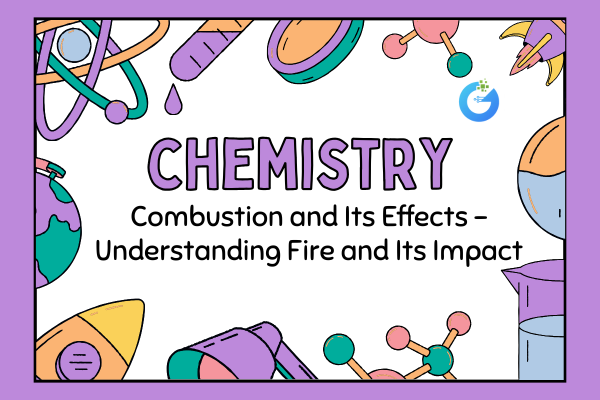Introduction – What Is Combustion?
Combustion is a chemical reaction that occurs when a substance combines with oxygen and releases energy in the form of heat and light. It’s what happens when something burns, like wood in a fire or fuel in a car engine. While combustion is essential for many everyday activities, it also has important effects on the environment, both positive and negative. The process plays a huge role in our daily lives, from providing us with energy to fueling transportation, but it also contributes to some environmental challenges.
expert-led Chemistry classes – visit our website to learn more
What Is Combustion?
Combustion is a type of chemical reaction where a substance reacts with oxygen to produce heat and light. The process requires three things, often called the fire triangle:
- Fuel – This is the material that burns, such as wood, paper, or gasoline.
- Oxygen – Combustion cannot happen without oxygen, which is usually supplied by the air.
- Heat – A spark, flame, or any heat source is necessary to start the combustion process.
When these three elements are present in the right amounts, combustion occurs, releasing energy in the form of heat and light. There are two main types of combustion:
- Complete Combustion – This happens when there is enough oxygen to burn the fuel completely, producing carbon dioxide (CO₂) and water (H₂O).
- Incomplete Combustion – This happens when there isn’t enough oxygen, leading to the production of carbon monoxide (CO) and possibly soot or other harmful substances.
The process of combustion is something we encounter in many forms: from the fire used to cook our food to the engines that power vehicles. But the efficiency of the process depends on how much oxygen is available. Incomplete combustion can be especially dangerous since it produces harmful gases.
What Are the Effects of Combustion?
While combustion is useful for many everyday activities, it can also have significant effects on both our health and the environment.
Positive Effects of Combustion: Combustion has been harnessed for centuries to provide us with energy and power. From cooking our food to driving our cars, combustion is essential for many of the things we do every day.
- Energy Production – Combustion is used to produce energy in power plants. These plants burn coal, natural gas, or oil to create electricity that powers homes, schools, and businesses.
- Transportation – Combustion in engines, like those in cars, buses, and airplanes, helps to power vehicles and make travel possible. Without combustion, modern transportation would not exist.
- Cooking – Combustion in stoves and grills allows us to cook food. Whether it’s a simple dinner or a festive barbecue, combustion plays a big role in meal preparation.
Negative Effects of Combustion: Despite its usefulness, combustion has several negative effects, especially when fossil fuels are burned.
- Air Pollution – Combustion of fossil fuels (like coal and oil) produces harmful gases such as carbon dioxide (CO₂), sulfur dioxide (SO₂), and nitrogen oxides (NOₓ), which contribute to air pollution. These pollutants can lead to smog and acid rain.
- Greenhouse Effect – The release of carbon dioxide during combustion adds to the greenhouse gases in the atmosphere, leading to global warming and climate change. These changes affect weather patterns, rising sea levels, and biodiversity loss.
- Health Issues – Incomplete combustion can produce carbon monoxide (CO), which is poisonous and can cause serious health problems, including suffocation. It’s especially dangerous in enclosed spaces like homes or garages.
The balance between these positive and negative effects is something we must carefully manage in order to protect the environment and human health.
Types of Combustion
Combustion can occur in different ways depending on how much oxygen is available. There are two main types of combustion:
- Complete Combustion – This type of combustion occurs when there is enough oxygen to burn the fuel fully. The products of complete combustion are mainly carbon dioxide (CO₂) and water (H₂O), both of which are relatively harmless. Complete combustion is cleaner and less harmful to the environment.
Example: Burning natural gas in a stove for cooking. - Incomplete Combustion – This occurs when there isn’t enough oxygen to burn the fuel completely. Incomplete combustion produces harmful products like carbon monoxide (CO), soot, and other pollutants, which can be dangerous to both health and the environment.
Example: A car engine or a campfire with limited oxygen supply.
By ensuring there’s enough oxygen during combustion, we can minimize the production of harmful byproducts.
The Environmental Impact of Combustion
Combustion, especially of fossil fuels, has several harmful effects on the environment. While it powers much of our modern society, it also contributes to environmental degradation.
- Air Pollution – Burning fuels releases pollutants like sulfur dioxide, nitrogen oxides, and particulate matter into the atmosphere. These pollutants can lead to smog, acid rain, and respiratory problems like asthma.
- Climate Change – The carbon dioxide released during combustion is a greenhouse gas. It traps heat in the Earth’s atmosphere, contributing to global warming. This causes rising temperatures, melting ice caps, and more extreme weather events.
- Deforestation – In some cases, combustion occurs when forests are burned for agriculture or to clear land. This can contribute to habitat loss, biodiversity decline, and more carbon being released into the atmosphere.
By transitioning to cleaner energy sources and reducing our dependence on fossil fuels, we can reduce the harmful environmental impacts of combustion.
Core Concepts – What You Should Know
Here’s a quick summary of the important terms you should understand:
| Term | Meaning | Example |
| Combustion | A chemical reaction where a substance reacts with oxygen to produce heat and light | Burning wood, gasoline in a car engine |
| Complete Combustion | Combustion with enough oxygen, producing carbon dioxide and water | Clean burning of natural gas |
| Incomplete Combustion | Combustion with limited oxygen, producing harmful pollutants like carbon monoxide | A poorly ventilated stove or engine |
| Air Pollution | The release of harmful gases into the air | Carbon monoxide, sulfur dioxide |
| Greenhouse Effect | The trapping of heat in the Earth’s atmosphere by greenhouse gases like carbon dioxide | Global warming and rising temperatures |
FAQs – Curious Questions About Combustion
Q1: Why does combustion produce heat and light?
Combustion releases energy stored in chemical bonds when a fuel reacts with oxygen. This energy is released as heat and light, which is why we see flames and feel warmth when something burns.
Q2: How can we reduce the harmful effects of combustion?
We can reduce harmful effects by using cleaner fuels, improving combustion efficiency (e.g., better engines), and increasing the use of renewable energy sources like wind and solar power, which don’t produce harmful emissions.
Q3: Is combustion always harmful to the environment?
Not always. While burning fossil fuels can be harmful, combustion of renewable sources like biomass or controlled burning for energy can be done with less harm to the environment. The key is managing it responsibly.
Fun Facts About Combustion
- The temperature of a flame can exceed 1,000°C in some cases, like in welding or fireworks!
- Combustion in power plants generates over 70% of the world’s electricity!
- In some countries, controlled burning of forests is used as a method to prevent wildfires and clear land for farming.
- The first light bulb was created using carbon filaments that burned through combustion!
Conclusion – Combustion: Power and Pollution
Combustion is a powerful process that helps us generate energy, travel, and cook, but it also comes with important environmental consequences. Understanding how combustion works and its effects on the environment can help us make better choices to minimize its harmful impacts. By using cleaner fuels and focusing on renewable energy, we can continue to benefit from combustion without damaging our planet.








